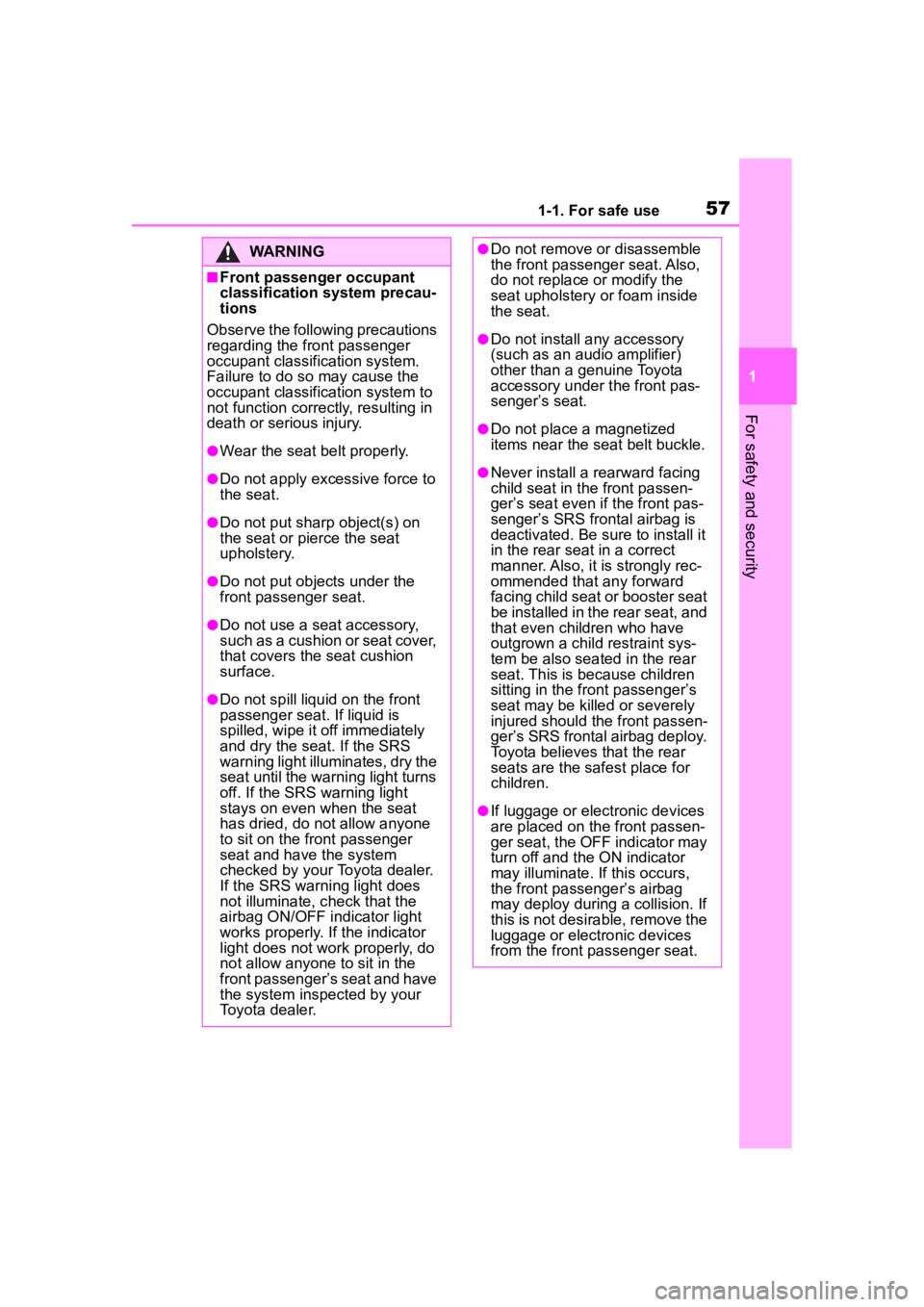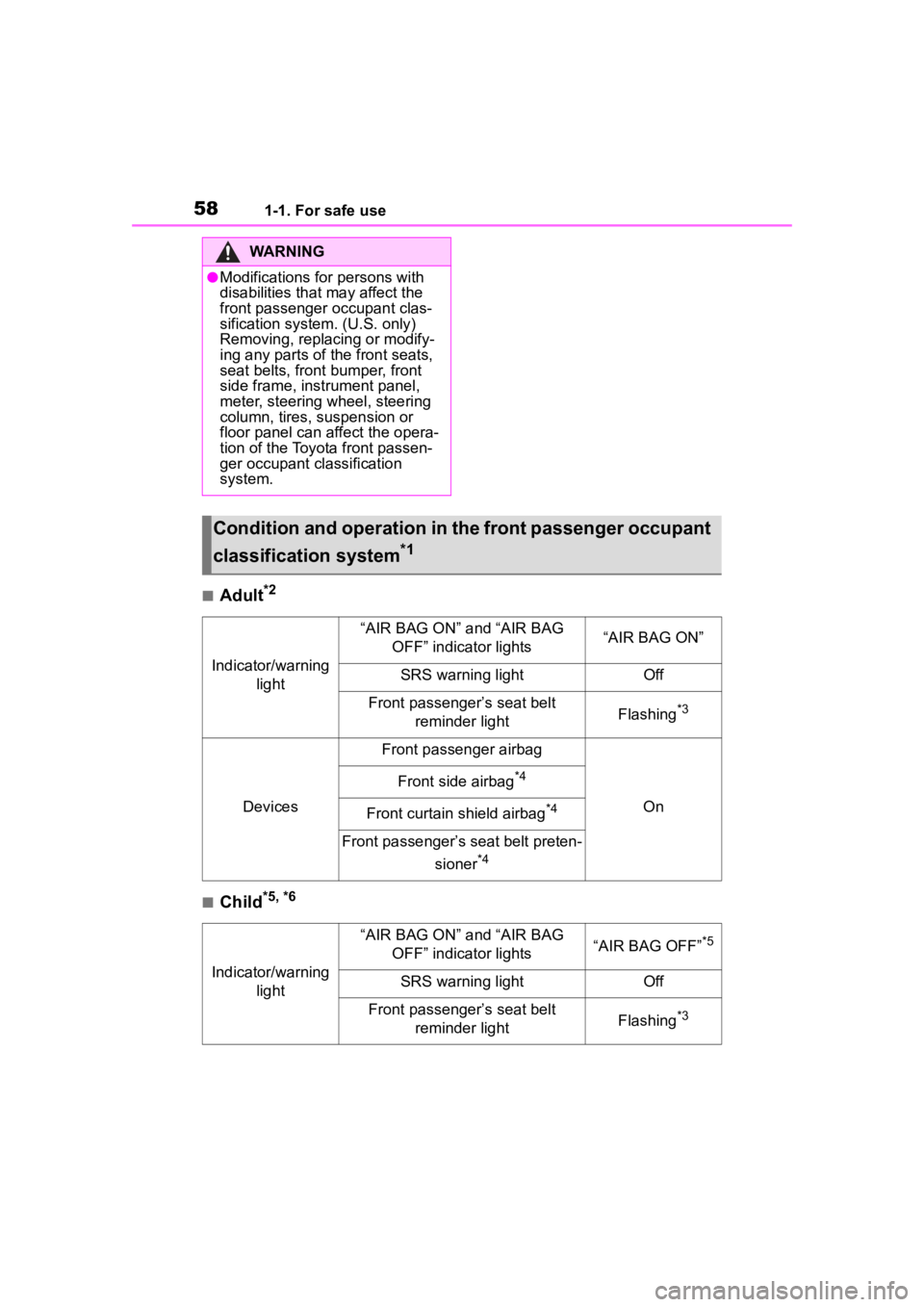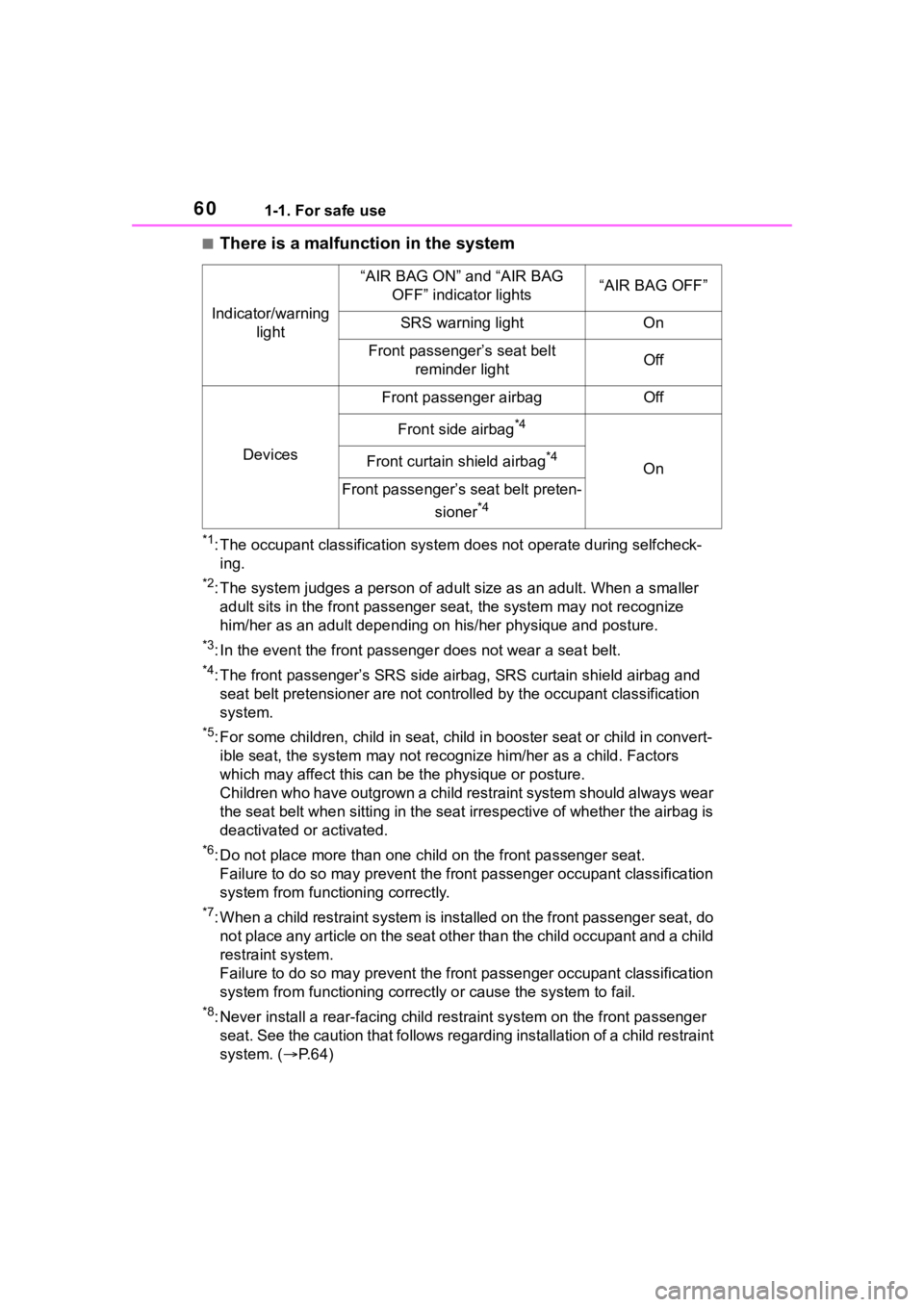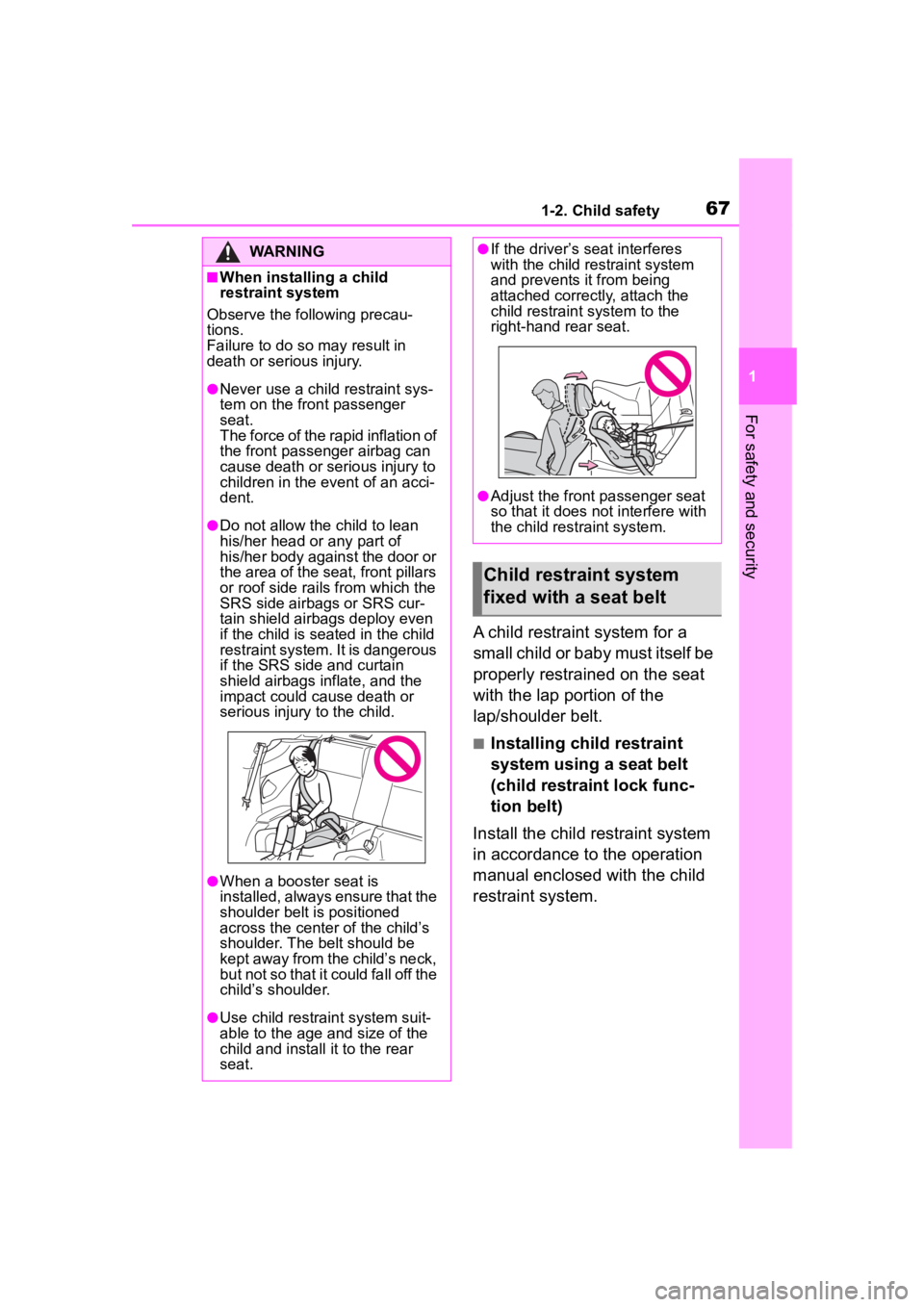2023 TOYOTA 86 airbag
[x] Cancel search: airbagPage 55 of 449

551-1. For safe use
1
For safety and security
Front impact sensor
• Right-hand side
• Left-hand side
Airbag control module (includ-
ing impact sensor and rollover
sensor)
Frontal airbag module
• Driver’s side
• Front passenger’s side
Knee airbag module
• Driver’s side
Side impact sensor
• Center pillar left-hand side
• Center pillar right-hand side
• Forward of rear wheel house
left-hand side
• Forward of rear wheel house right-hand side
• Door left-hand side
• Door right-hand side
Side airbag module
• Driver’s side
• Front passenger’s side
Curtain shield airbag module
• Right-hand side
• Left-hand side
Seatbelt pretensioner
• Driver’s side
Seatbelt pretensioner and
adaptive force limiter
• Front passenger’s side
Seatbelt buckle switch
• Front passenger’s side
Front passenger’s occupant detection system sensors
Front passenger’s frontal air-
bag ON and OFF indicator
All related wiring
■SRS warning light
Have the system inspected by your
Toyota dealer i mmediately if the
SRS warning light illuminates.
WARNING
■SRS warning light
If the warning light exhibits any of
the following conditions, immedi-
ately stop the vehicle in a safe
place, and consult a Toyota
dealer. Unless a technician
checks and repairs the system as
needed, the seatbelt pretension-
ers and/or the SRS airbag may
not operate properl y in the event
of a collision, which may result in
injury.
●Flashing or flickering of the
warning light
●No illumination of the warning
light when the engine switch is
first turned to ON
●Continuous illumination of the
warning light
●Illumination of the warning light
while driving
Page 56 of 449

561-1. For safe use
The front passenger’s frontal airbag ON and OFF indicators show
you the status of the front passenger’s SRS frontal airbag. When the
engine switch is turned to ON, both the ON and OFF indicators illu-
minate while the system is checked, after which both indicators turn
off.
After that, one of the indicators illuminates depending on the status
of the front passenger’s SRS frontal airbag determined by the T oyota
advanced frontal airbag monitoring system.
SRS warning light
Front passenger’s seat belt reminder light
“AIR BAG OFF” indicator light
“AIR BAG ON” indicator light
Front passenger occupant classification system
Your vehicle is equipped with a front passenger occupant
classification system. This system detects the conditions of
the front passenger seat and activates or deactivates the front
passenger airbag.
System components
A
C
D
Page 57 of 449

571-1. For safe use
1
For safety and security
WARNING
■Front passenger occupant
classification system precau-
tions
Observe the following precautions
regarding the front passenger
occupant classification system.
Failure to do so may cause the
occupant classifi cation system to
not function correctly, resulting in
death or serious injury.
●Wear the seat belt properly.
●Do not apply excessive force to
the seat.
●Do not put sharp object(s) on
the seat or pierce the seat
upholstery.
●Do not put objects under the
front passenger seat.
●Do not use a seat accessory,
such as a cushion or seat cover,
that covers the seat cushion
surface.
●Do not spill liqui d on the front
passenger seat. If liquid is
spilled, wipe it off immediately
and dry the seat. If the SRS
warning light illumi nates, dry the
seat until the warning light turns
off. If the SRS warning light
stays on even when the seat
has dried, do not allow anyone
to sit on the front passenger
seat and have the system
checked by your Toyota dealer.
If the SRS warning light does
not illuminate, check that the
airbag ON/OFF indicator light
works properly. If the indicator
light does not work properly, do
not allow anyone to sit in the
front passenger’s seat and have
the system inspected by your
Toyota dealer.
●Do not remove or disassemble
the front passenger seat. Also,
do not replace or modify the
seat upholstery or foam inside
the seat.
●Do not install any accessory
(such as an audio amplifier)
other than a genuine Toyota
accessory under t he front pas-
senger’s seat.
●Do not place a magnetized
items near the seat belt buckle.
●Never install a rearward facing
child seat in the front passen-
ger’s seat even if the front pas-
senger’s SRS frontal airbag is
deactivated. Be sure to install it
in the rear seat in a correct
manner. Also, it is strongly rec-
ommended that any forward
facing child seat or booster seat
be installed in the rear seat, and
that even children who have
outgrown a child restraint sys-
tem be also seated in the rear
seat. This is because children
sitting in the front passenger’s
seat may be killed or severely
injured should the front passen-
ger’s SRS frontal airbag deploy.
Toyota believes that the rear
seats are the safest place for
children.
●If luggage or electronic devices
are placed on the front passen-
ger seat, the OFF indicator may
turn off and the ON indicator
may illuminate. If this occurs,
the front passenger’s airbag
may deploy during a collision. If
this is not desirable, remove the
luggage or electronic devices
from the front passenger seat.
Page 58 of 449

581-1. For safe use
■Adult*2
■Child*5, *6
WARNING
●Modifications for persons with
disabilities that may affect the
front passenger occupant clas-
sification system. (U.S. only)
Removing, replacing or modify-
ing any parts of the front seats,
seat belts, front bumper, front
side frame, instrument panel,
meter, steering wheel, steering
column, tires, suspension or
floor panel can affect the opera-
tion of the Toyota front passen-
ger occupant classification
system.
Condition and operation in the front passenger occupant
classification system
*1
Indicator/warning light
“AIR BAG ON” and “AIR BAG OFF” indicator lights“AIR BAG ON”
SRS warning lightOff
Front passenger’s seat belt reminder lightFlashing*3
Devices
Front passenger airbag
On
Front side airbag*4
Front curtain shield airbag*4
Front passenger’s seat belt preten-
sioner
*4
Indicator/warning light
“AIR BAG ON” and “AIR BAG OFF” indicator lights“AIR BAG OFF”*5
SRS warning lightOff
Front passenger’s seat belt reminder lightFlashing*3
Page 59 of 449

591-1. For safe use
1
For safety and security■Child restraint system with infant*6, *7, *8
■Unoccupied
Devices
Front passenger airbagOff
Front side airbag*4
OnFront curtain shield airbag*4
Front passenger’s seat belt preten-sioner
*4
Indicator/warning light
“AIR BAG ON” and “AIR BAG OFF” indicator lights“AIR BAG OFF”*9
SRS warning light
OffFront passenger’s seat belt reminder light
Devices
Front passenger airbagOff
Front side airbag*4
OnFront curtain shield airbag*4
Front passenger’s seat belt preten-
sioner
*4
Indicator/warning light
“AIR BAG ON” and “AIR BAG OFF” indicator lights“AIR BAG OFF”
SRS warning light
OffFront passenger’s seat belt reminder light
Devices
Front passenger airbagOff
Front side airbag*4
OnFront curtain shield airbag*4
Front passenger’s seat belt preten-
sioner
*4
Page 60 of 449

601-1. For safe use
■There is a malfunction in the system
*1: The occupant classification system does not operate during selfcheck-
ing.
*2: The system judges a person of adult size as an adult. When a smaller
adult sits in the front passenger seat, the system may not recognize
him/her as an adult depending on his/her physique and posture.
*3: In the event the front passenge r does not wear a seat belt.
*4: The front passenger’s SRS side airbag, SRS curtain shield airbag and
seat belt pretensioner are not c ontrolled by the occupant classification
system.
*5: For some children, child in seat, child in booster seat or chi ld in convert-
ible seat, the system may not recognize him/her as a child. Fac tors
which may affect this can be the physique or posture.
Children who have outgrown a child restraint system should alwa ys wear
the seat belt when sitting in the seat irrespective of whether the airbag is
deactivated o r activated.
*6: Do not place more than one child on the front p assenger seat.
Failure to do so may prevent the front passenger occupant class ification
system from functioning correctly.
*7: When a child restraint system is installed on the front passen ger seat, do
not place any article on the seat other than the child occupant and a child
restraint system.
Failure to do so may prevent the front passenger occupant class ification
system from functioning correctly or cause the system to fail.
*8: Never install a rear-facing ch ild restraint system on the front passenger
seat. See the caution that follows regarding installation of a child restraint
system. ( P.64)
Indicator/warning
light
“AIR BAG ON” and “AIR BAG OFF” indicator lights“AIR BAG OFF”
SRS warning lightOn
Front passenger’s seat belt reminder lightOff
Devices
Front passenger airbagOff
Front side airbag*4
OnFront curtain shield airbag*4
Front passenger’s seat belt preten-
sioner
*4
Page 67 of 449

671-2. Child safety
1
For safety and security
A child restraint system for a
small child or baby must itself be
properly restrained on the seat
with the lap portion of the
lap/shoulder belt.
■Installing child restraint
system using a seat belt
(child restraint lock func-
tion belt)
Install the child restraint system
in accordance to the operation
manual enclosed with the child
restraint system.
WARNING
■When installing a child
restraint system
Observe the following precau-
tions.
Failure to do so m ay result in
death or serious injury.
●Never use a child restraint sys-
tem on the front passenger
seat.
The force of the rapid inflation of
the front passenger airbag can
cause death or serious injury to
children in the event of an acci-
dent.
●Do not allow the child to lean
his/her head or any part of
his/her body against the door or
the area of the seat, front pillars
or roof side rails from which the
SRS side airbags or SRS cur-
tain shield airbags deploy even
if the child is seated in the child
restraint system. It is dangerous
if the SRS side and curtain
shield airbags inflate, and the
impact could cause death or
serious injury to the child.
●When a booster seat is
installed, always ensure that the
shoulder belt is positioned
across the center of the child’s
shoulder. The belt should be
kept away from the child’s neck,
but not so that it could fall off the
child’s shoulder.
●Use child restraint system suit-
able to the age and size of the
child and install it to the rear
seat.
●If the driver’s seat interferes
with the child restraint system
and prevents it from being
attached correct ly, attach the
child restraint system to the
right-hand rear seat.
●Adjust the front passenger seat
so that it does not interfere with
the child restraint system.
Child restraint system
fixed with a seat belt
Page 77 of 449

771-3. Emergency assistance
1
For safety and security
illuminate and then turn off.
Then, the green indicator light
will illuminate to indicate that the
service is active.
The following indicator light pat-
terns indicate specific system
usage conditions:
Green indicator light on =
Active service
Green indicator light flashing
= Safety Connect call in pro-
cess
Red indicator light on (except
at vehicle start-up) = System
malfunction (contact your Toy-
ota dealer)
No indicator light (off) =
Safety Connect service not
active
■Automatic Collision Notifi-
cation
In case of either airbag deploy-
ment or severe rear-end colli-
sion, the system is designed to
automatically call the response
center. The responding agent
receives the vehicle’s location
and attempts to speak with the
vehicle occupants to assess the
level of emergency. If the occu-
pants are unable to communi-
cate, the agent automatically
treats the call as an emergency,
contacts the nearest emer-
gency services provider to describe the situation, and
requests that assistance be sent
to the location.
■Stolen Vehicle Location
If your vehicle is stolen, Safety
Connect can work with local
authorities to assist them in
locating and recovering the
vehicle. After filing a police
report, call the Customer Experi-
ence Center at 1-800-331-4331
in the United States or
1-888-869-6828 in Canada, and
follow the prompts for Safety
Connect to initiate this service.
In addition to assisting law
enforcement with recovery of a
stolen vehicle, Safety-Con-
nect-equipped vehicle location
data may, under certain circum-
stances, be shared with third
parties to locate your vehicle.
Further information is available
at Toyota.com in the United
States and Toyota.ca in Canada.
■Emergency Assistance But-
ton (“SOS” button)
In the event of an emergency on
the road, push the “SOS” button
to reach the Safety Connect
response center. The answer-
ing agent will determine your
vehicle’s location, assess the
emergency, and dispatch the
necessary assistance required.
If the “SOS” button is pressed unin-
tentionally, press and hold the
“SOS” button for approximately 2
seconds or more or operate the
Safety Connect services